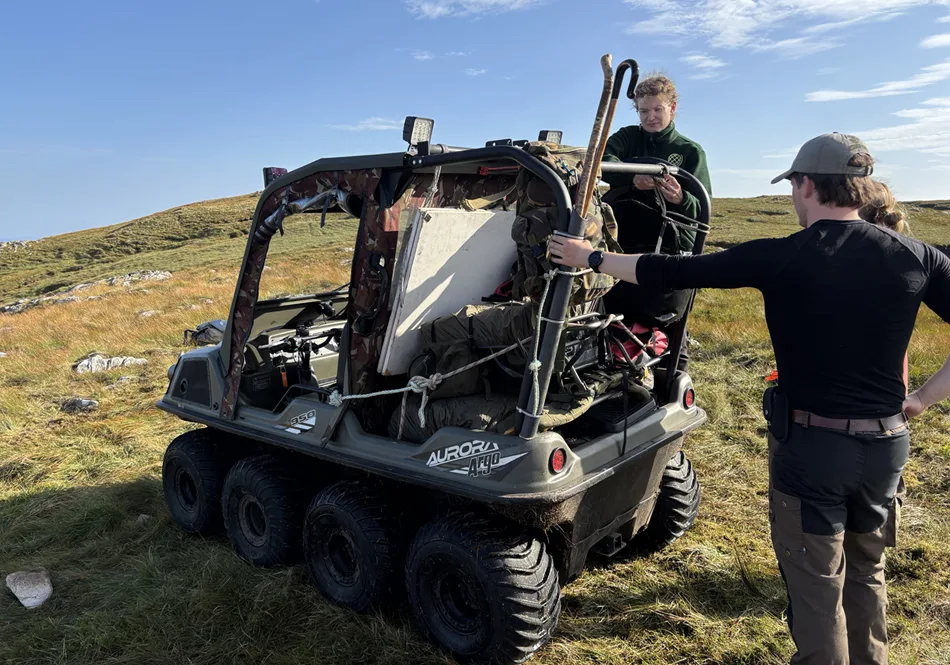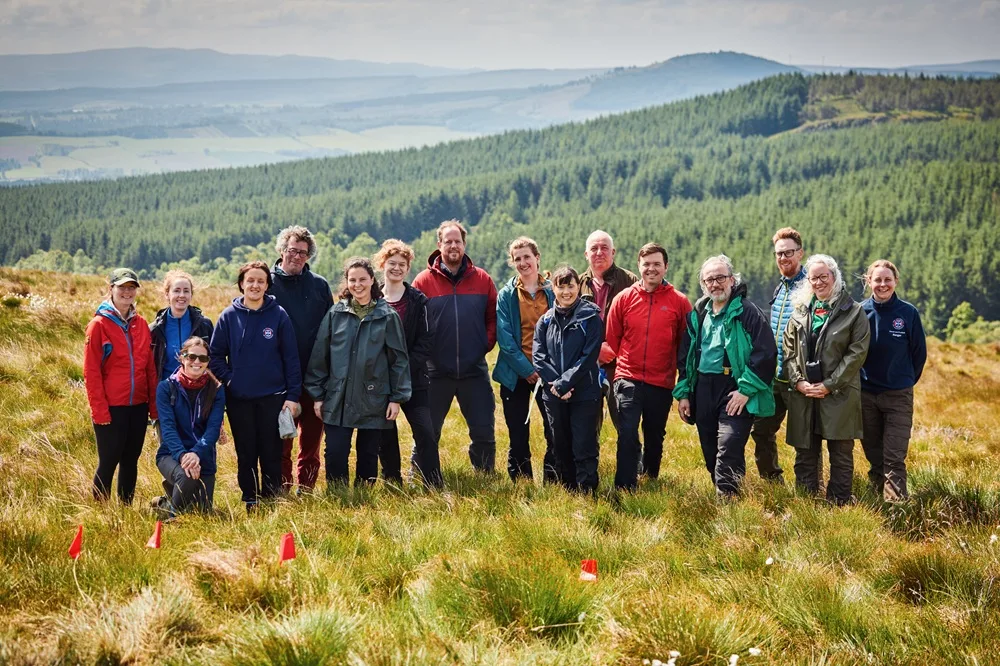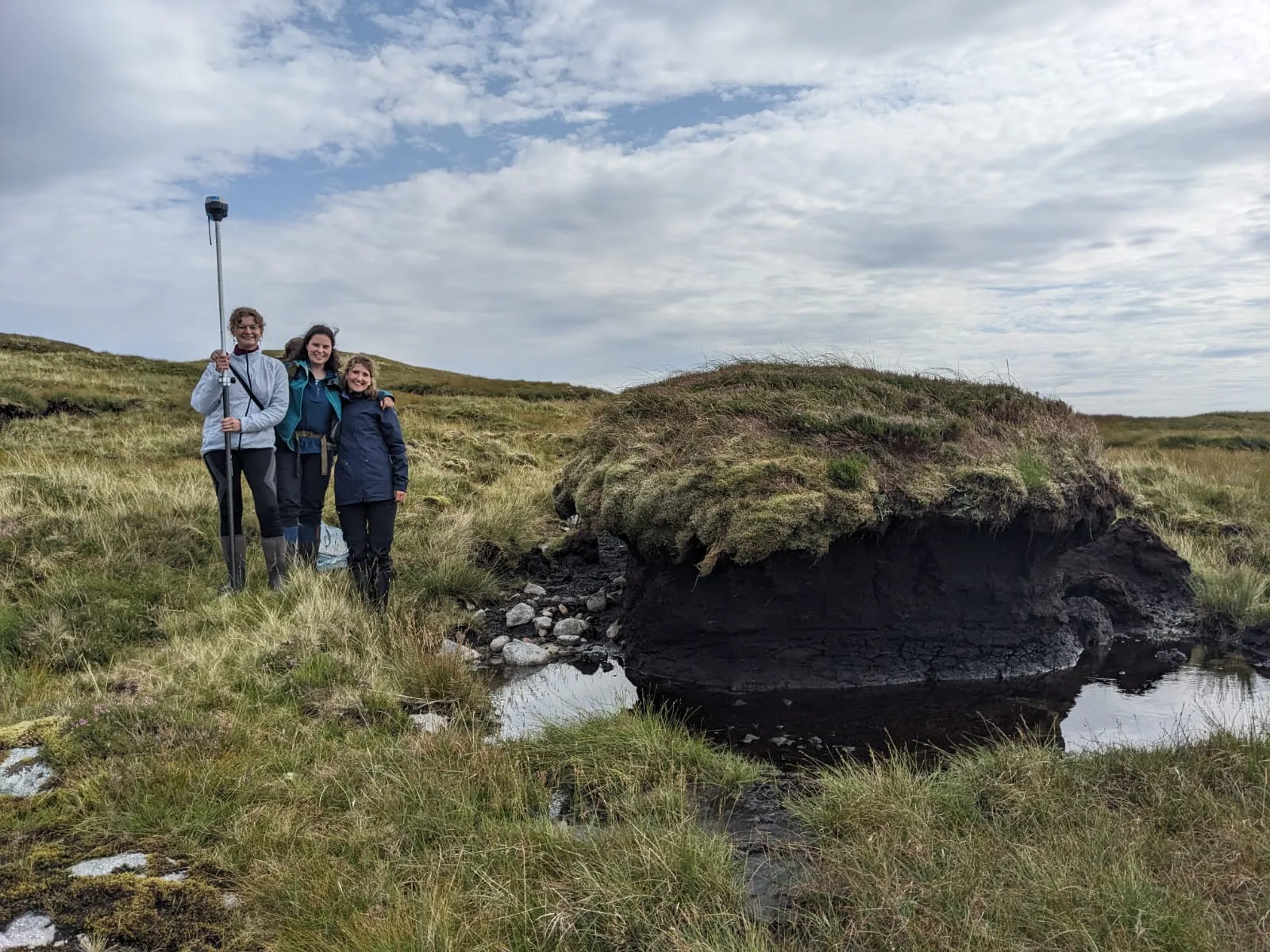The country is experiencing a biodiversity crisis. Less than half of native woodland cover remains healthy and a large majority of peatlands are suffering degradation.
Rising climate and biodiversity pressures are driving organisations to adopt integrated ‘nature-based’ approaches to address these challenges.
In 2021, the University launched an ambitious programme to capture and store its unavoidable emissions and benefit nature by restoring woodland and peatlands across Scotland. Working with partners and landowners, the Forest and Peatland Programme will regenerate around 5,600 hectares of land over the next 50 years.
PhD students Mareike Feldmann, Tilda Tarrant and Rachel Orchard recently joined the programme to assess and guide its activities. Using several sites as ‘living laboratories’, the students will monitor carbon, biodiversity and community impacts of woodland and peatland recovery.
Their research will provide an evidence-based approach to assess the programme’s progress. Programme leaders hope it will help shape future policy and practice into restoration efforts to combat climate and nature loss in Scotland and beyond.
Research in motion
Alongside baseline data, Mareike, Tilda and Rachel are conducting onsite fieldwork together to build a dataset that will create a detailed assessment of the programme’s impacts.
On a typical day at one of the University’s partner sites at Ardtornish Estate1, the students begin their workday early. Drones, GPS receivers, soil augers, sample tubes, and batteries (alongside a box of Greggs’ yum-yums) are packed into the car.

Once on site, some of the team hike while heavier gear goes into one of the Estate’s ArgoCats, an eight-wheeled vehicle capable of navigating rough terrain.
Following a long journey across boggy land and rocky outcrops, the team make it to site and begin set up.
Data is collected in three forms: soil cores, vegetation surveys and drones collecting detailed images and measurements of the land.
Together these methods provide a comprehensive view of how the site is changing both above and below the surface.

Representing the University’s three Colleges, Mareike, Tilda and Rachel bring diverse and complementary perspectives to the Forest and Peatland Programme.
Combatting climate change
Mareike’s PhD focuses on the monitoring of soil carbon sequestration. Peatlands are one of the most important carbon sinks worldwide, but once damaged they begin to release carbon back into the atmosphere.
Mareike will use the samples collected from their fieldwork to measure how restored peat and forest soils absorb and store carbon over time.
She hopes to use the data to build carbon stock models of sites to track the amount of carbon stored.
“The models will train classification algorithms to find indicators in the remote sensing data,” explains Mareike. “Importantly it allows us to monitor soil carbon stocks without needing more invasive methods of soil sampling.”
Reversing nature loss
While carbon sequestration is a crucial to the University’s own net zero plans, the objectives on the project extend further. It has been purposely designed to be a nature-based solution, one that benefits biodiversity too.
Tilda Tarrant’s PhD will explore approaches to monitor how the restoration methods impact biodiversity recovery and ecosystem resilience.
Tilda will use the data they collect to extract environmental DNA (eDNA) and sequence to see what is present at the field sites, looking at fungi, bacteria and insects alongside plant life.
Remote sensing and 3D models will help track changes in vegetation structure and tree establishment. Ground surveys of plant species and abundance will also help her validate results from eDNA and remote sensing models.

Monitoring progress through data collection is an important part of restoration. It will allow the Forest and Peatlands team to make informed decisions on future strategies.
“Both eDNA and remote sensing monitoring techniques are powerful, but they function at such different scales and rarely overlap.” Tilda explains. “I want to see how combining these diverse approaches can advance monitoring capabilities beyond what each could detect separately.”
Working with communities
To build a complete picture to inform restoration efforts, the project team are also documenting how work affects communities living closeby.
Rachel Orchard’s PhD focuses on the social and community dimensions of restoration. In particular, she will explore how different community groups, such as estate workers, restoration contractors, researchers, landowners and local residents, experience and relate to restoration work.
Rachel will use University-owned sites and partner sites to understand and monitor how these relations compare across different restoration contexts.
Her research will help the programme better understand the power dynamics involved in establishing restoration projects, the social benefits they provide, and how to track those impacts over time.
During a recent visit to Ardtornish Estate, the three students met with the estate’s land manager. They learned more about the objectives behind the site’s restoration plans and efforts to involve the wider community.
The conversation subsequently generated ideas for how social research could better support work on the ground.
“Its a great opportunity to follow and understand the social processes of nature restoration.” Rachel says, “A key part of my research will be to gather and share stories of interactions with the land and restoration work with an open-access approach to build a network of experiences across each site.”
From data to decisions
Meanwhile, back on campus, data from drones, samples and field instruments are uploaded and cross-referenced.
The students will also draw on expertise from peatland monitoring in the School of Chemistry, eDNA soil analysis at the School of Veterinary Science and Roslin Institute, and remote sensing work led in collaboration with the School of Geosciences.
Their research will have a direct input in how the University’s and partner sites manage restoration.
But for Mareike, Tilda and Rachel, the collaborative nature of their work is just as vital as the data itself.
“It’s a fantastic opportunity to work in an interdisciplinary group of researchers all approaching the same question, ‘how we can monitor restoration progress in forest and peatlands?’ from different angles,” Tilda says.
Learning from the land
With climate and sustainability teaching a core part of the University’s curriculum, developments are underway to expand teaching, learning and research possibilities at its forest and peatlands sites.
Alongside PhD studentships and research projects, the sites will increasingly be used to host course-specific fieldtrips.
Opportunities are also being extended to schools in the local communities, offering young people hands-on outdoor educational experiences just a stone’s throw from where they live.





